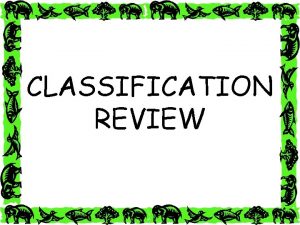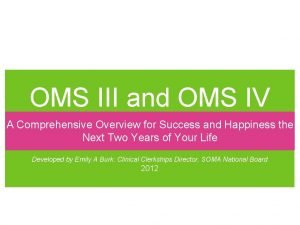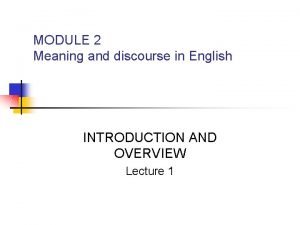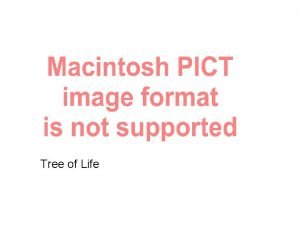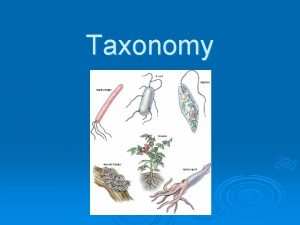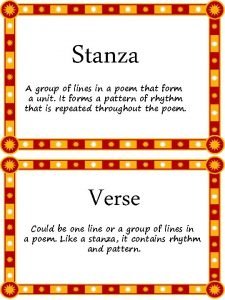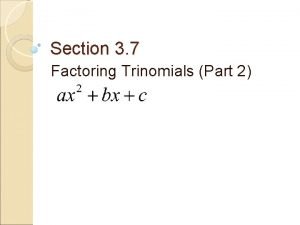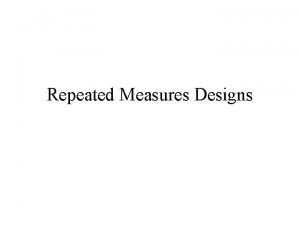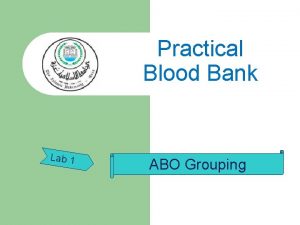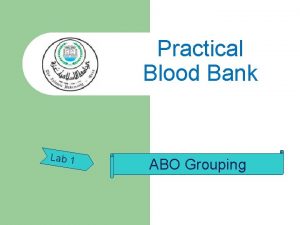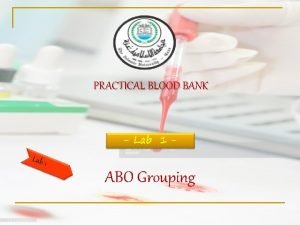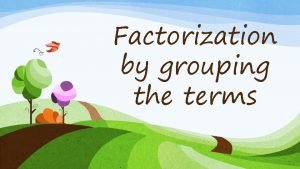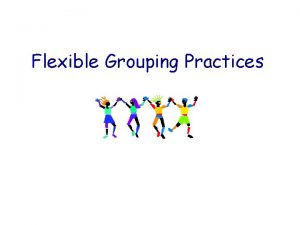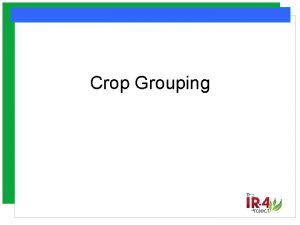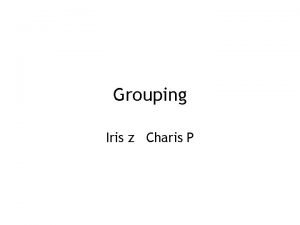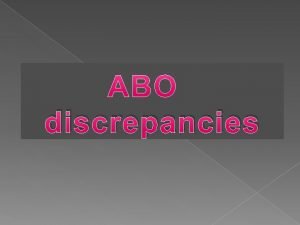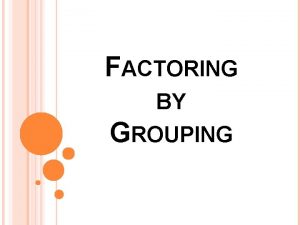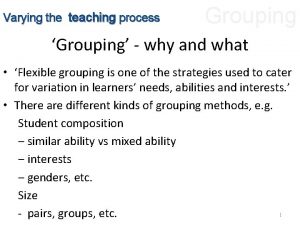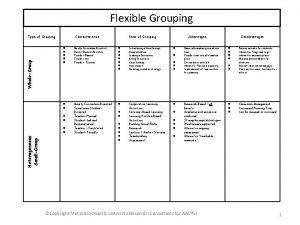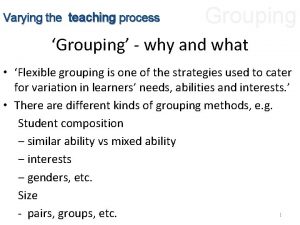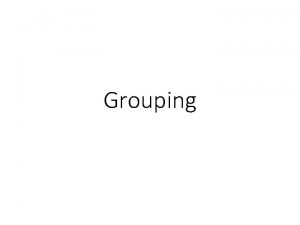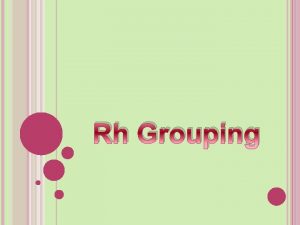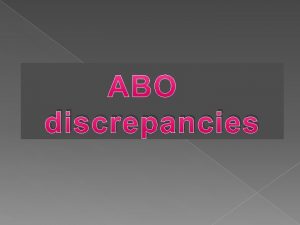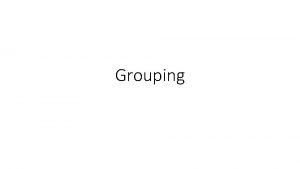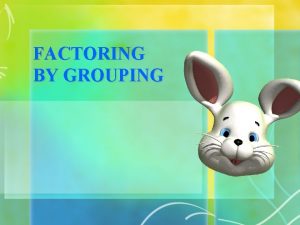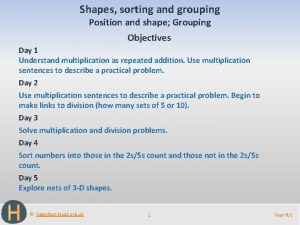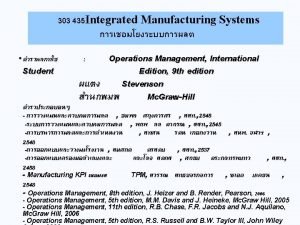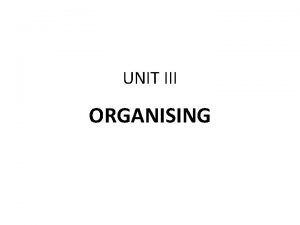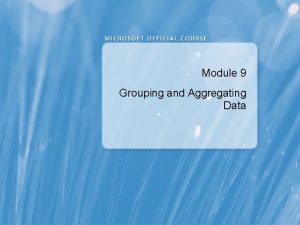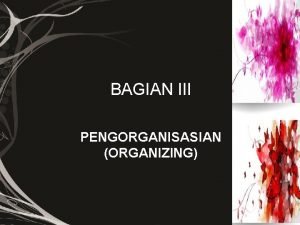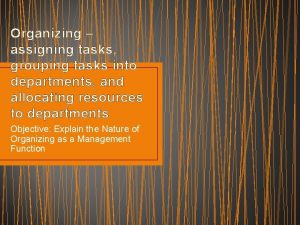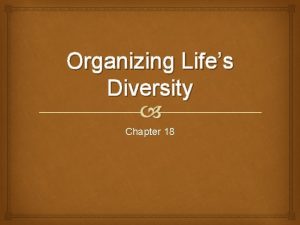ORGANIZING MODULE III Meaning of Organizing The grouping
























































- Slides: 56

ORGANIZING MODULE III

Meaning of Organizing • The grouping of activities necessary to attain objectives, • The identification and classification of required activities • The assignment of each grouping to a manager with the authority (delegation) necessary to supervise it, • Establishing a network of authority and responsibility • The provision for coordination horizontally (on the same or a similar organizational level) and vertically (e. g. , corporate headquarters, division, and department) in the organization structure.

Definition Organizing is the process of identifying and grouping the work to be performed, defining and delegating responsibility and authority, and establishing relationships for the purpose of enabling people to work most effectively together in accomplishing objectives. Louis Allen

Definition • Organizing is the process of arranging and allocating work, authority, and resources among an organization’s members so that they can achieve organizational goal. �Stoner, Freeman and Gilbert • Organizing is the process by which employees, facilities and tasks are related to each other, with a view to achieve specific goals. It refers the way, work is arranged and allocated among members of the organization, so as to achieve the goals.

ORGANIZING • The process of organizing involves the following steps ▫ ▫ ▫ Identifying the work Grouping the work Establishing relationship Delegating authority Providing for coordination and control

Importance of Organizing • • • Benefits of specialization Clarity in working relationships Optimum utilization of resources Adaptation to change Development of personnel Expansion and growth

Objectives of Organizing • Divide work to be done into specific jobs and Departments • Assign tasks and responsibilities associated with individual • Coordinates diverse organizational tasks. • Clusters job in to Units. • Establish relationship among individuals, group, and departments. • Allocates and deploys organizational resources.

Elements in Organizing process • • • Work Specialization Departmentalization Chain of command Centralization and Decentralization Formalization Span of Control

Process of Organizing simplified

Organizing Process • Identifying, analyzing and classifying the activities necessary to accomplish the objectives • Grouping these activities in the light of human and material resources available and the best way under the circumstances , of using them • Delegation of authority (Assignment of duties ) • Horizontal and vertical coordination of authority and information relationship

Organizing Process Feasibility studies and feedback IDENTIFICATION AND CLASSIFICATION OF REQUIREDS ACTIVITIES GROUPING OF ACTIVITIES IN THE LIGHT OF RESOURCES AND SITUATIONS DELEGATION OF AUTHORITY HORIZONTAL AND VERTICAL COORDINATION OF AUTHORITY AND INFORMATION RELATIONSHIP

Formal and Informal Organization

Formal Organization • The Formal Organization is a system of well-defined jobs, each bearing a definite measure of authority, responsibility and accountability. Louis Allen • Formal Organization is a system of consciously coordinated activities of two or more persons toward a common objective. Chester Barnard

Features • It is deliberately designed by the top management • It places more emphasis on work to be performed than interpersonal relationships among the employees. • It specifies the relationships among various job positions and the nature of their inter-relationship. • It lays down rules and procedures essential for achievement of objective • Efforts of various departments are coordinated, interlinked and integrated through the formal organisation.

Formal Organizations

Features • It is deliberately designed by the top management • It places more emphasis on work to be performed than interpersonal relationships among the employees. • It specifies the relationships among various job positions and the nature of their inter-relationship. • It lays down rules and procedures essential for achievement of objective • Efforts of various departments are coordinated, interlinked and integrated through the formal organisation.

Advantages • Easier to fix Responsibility • No ambiguity in the role. This also helps in avoiding duplication of effort. • Behavior of Employee fairly predicted • Unity of command through an established chain of command • Stability to the organization

Limitations • The formal communication may lead to procedural delays • Do not provide adequate recognition to creative talent • More emphasis on Structure and Work, difficult to understand all human relationships in an enterprise as it places.

Informal Organization • An Informal organization is an aggregate of interpersonal relationships without any conscious purpose but which may contribute to joint results. Chester Barnard • Informal organization is a network of interpersonal relationship that arise when people associate with one another. Keith Davis

Features • Originates from within the formal organisation as a result of personal interaction among employees. • The standards of behavior evolve from group norms. • Independent channels of communication without specified direction of flow of information are developed by group members. • Emerges spontaneously and is not deliberately created by the management.

A B C D J E K L C F M N H G 0 P Q R I T U V

Chess group Cricket lovers Bowling Team Morning coffeee regulars

Advantages • It helps to fulfill the social needs. • Sense of belongingness in the organisation • Faster spread of information as well as quick feedback. • It contributes towards fulfillment of organizational objectives. For example, employees reactions towards plans and policies can be tested through the informal network.

Disadvantages • It spreads rumors. This may work against the interest of the formal organisation. • The management may not be successful in implementing changes if the informal organisation opposes them. Such resistance to change may delay or restrict growth. • It pressurizes members to conform to group expectations.

Formal and Informal Organization: A Comparative view • • Meaning Origin Authority Behavior Flow of Communication Nature Leadership

Principle of the Span of management or control • There is a limit to the number of persons an individual can effectively manage. ▫ Organization with Narrow Span ▫ Organization with Wide Span

Organization with Narrow Span A B E C F G D H I J K L

Advantage Disadvantage • Close supervision • Close control • Fast communication between subordinates and superiors • Subordinates tend to get involved in Subordinates Work • Many Levels of Management • High Costs due to many levels • Excessive distance between lowest level and top level

Organization With Wide Span

Advantages • Superior are forces to delegate • Clear polices must be made • Subordinate must be carefully selected Disadvantage • Tendency of overloaded • Danger of superiors loss of control • Requires exceptional quality of Managers

Organizational Structure • Organizational Architecture ▫ The organizational structure, control systems, culture, and human resource management systems that together determine how efficiently and effectively organizational resources are used.

What Is Organizational Structure? • Organizational Structure ▫ How job tasks are formally divided, grouped, and coordinated ▫ Key Elements: 1. 2. 3. 4. 5. 6. Work specialization Departmentalization Chain of command Span of control Centralization and decentralization Formalization

1. Work Specialization • The degree to which tasks in the organization are subdivided into separate jobs • Division of Labor ▫ Makes efficient use of employee skills ▫ Increases employee skills through repetition ▫ Less between-job downtime increases productivity ▫ Specialized training is more efficient

2. Departmentalization • The basis by which jobs are grouped together • Grouping Activities by: ▫ Function ▫ Product ▫ Geography ▫ Process ▫ Customer

3. Chain of Command • Authority ▫ The rights inherent in a managerial position to give orders and to expect the orders to be obeyed • Chain of Command ▫ The unbroken line of authority that extends from the top of the organization to the lowest echelon and clarifies who reports to whom • Unity of Command ▫ A subordinate should have only one superior to whom he or she is directly responsible 16 -35

4. Span of Control The number of subordinates a manager can efficiently and effectively direct. Span of control refers to the number of subordinates a supervisor has. ▫ Wider spans of management increase organizational efficiency ▫ Narrow span drawbacks: ▫ Expense of additional layers of management �Increased complexity of vertical communication �Encouragement of overly tight supervision and discouragement of employee autonomy

5. Centralization and Decentralization • Centralization ▫ The degree to which decision making is concentrated at a single point in the organization. • Decentralization ▫ The degree to which decision making is spread throughout the organization.

Centralized vs. Decentralized • In a centralized organization: ▫ people have little autonomy ▫ norms that focus on being cautious, obeying authority, and respecting traditions emerge ▫ predictability and stability are desired goals • In a flat, decentralized structure: ▫ people have more freedom to choose and control their own activities ▫ norms that focus on being creative and courageous and taking risks appear ▫ gives rise to a culture in which innovation and flexibility are desired goals.

6. Formalization • The degree to which jobs within the organization are standardized. ▫ High formalization �Minimum worker discretion in how to get the job done �Many rules and procedures to follow ▫ Low formalization �Job behaviors are non-programmed �Employees have maximum discretion 16 -39

Organizational Architecture/Structure ▫ Vertical differentiation �Tall versus Flat Structure ▫ Horizontal differentiation �Functional Structure �Multidivisional/ Divisional Structure �Geographic Structure �Matrix Structure

Tall and Flat Organizations • Tall structures have many levels of authority and narrow spans of control. ▫ As hierarchy levels increase, communication gets difficult creating delays in the time being taken to implement decisions. ▫ Communications can also become distorted as it is repeated through the firm. ▫ Can become expensive

Tall Organizations

Tall and Flat Organizations • Flat structures have fewer levels and wide spans of control. ▫ Structure results in quick communications but can lead to overworked managers.

Tall Versus Flat Organizations Tall Organization Flat Organization President

Organizational architecture – Vertical integration Tall Organization Flat organization • This type of organizational architecture has many layers and narrow span of control. • This type of organizational architecture has few layers and wide span of control.

ORGANIZATIONAL ARCHITECTURE – HORIZONTAL DIFFERENTIATION 1. Functional Structure: • Structure is created based on the various functions of an organization. • An organizational structure composed of all the departments that an organization requires to produce its goods or services. General Manager Production Dept Finance Dept Marketing Dept HR Department

2. Multi-Division/ Divisional structure General Manager Division III • Multiple divisions are created in a related industry. • Managers create a series of business units to produce a specific kind of product for a specific kind of customer

Types of Divisional Structure 1. Product Structure 2. Geographic Structure 3. Market Structure

Types of Divisional Structures • Product Structure ▫ Managers place each distinct product line or business in its own self-contained division ▫ Divisional managers have the responsibility for devising an appropriate business-level strategy to allow the division to compete effectively in its industry

Product Structure • Allows functional managers to specialize in one product area • Division managers become experts in their area • Removes need for direct supervision of division by corporate managers • Divisional management improves the use of resources

Types of Divisional Structures • Geographic Structure ▫ Divisions are broken location/regions down by geographic ▫ All the activities in one geographic region is categorized into one unit. • Global geographic structure ▫ Managers locate different divisions in each of the world regions where the organization operates. ▫ Generally, occurs when managers pursuing a multi-domestic strategy are

Types of Divisional Structures • Market Structure ▫ Groups divisions according to the particular kinds of customers they serve ▫ Allows managers to be responsive to the needs of their customers and act flexibly in making decisions in response to customers’ changing needs

Matrix Design Structure • Matrix Structure ▫ An organizational structure that simultaneously groups people and resources by function and product. �Results in a complex network of superiorsubordinate reporting relationships. �The structure is very flexible and can respond rapidly to the need for change. �Each employee has two bosses (functional manager and product manager) and possibly cannot satisfy both.

Matrix Structure

Matrix Structure • Advantages: ▫ Enhances organizational flexibility. ▫ Team members have the opportunity to learn new skills. ▫ Provides an efficient way for the organization to use its human resources. ▫ Team members serve as bridges to their departments for the team. • Disadvantages: ▫ Employees are uncertain about reporting relationships. ▫ The dynamics of group behavior may lead to slower decision making, one-person domination, compromise decisions, or a loss of focus. ▫ More time may be required for coordinating task-related activities.

References • Gareth R. Jones. Contemporary Management, Tata Mc. Graw hill publication. • VSP Rao. Management, Excel Publication. • Koontz & Weilrich. Management.
 Grouping things together is called
Grouping things together is called Hamlet act iii scene iii
Hamlet act iii scene iii C device module module 1
C device module module 1 Requirements for erf t2
Requirements for erf t2 Oms iv
Oms iv Hát kết hợp bộ gõ cơ thể
Hát kết hợp bộ gõ cơ thể Lp html
Lp html Bổ thể
Bổ thể Tỉ lệ cơ thể trẻ em
Tỉ lệ cơ thể trẻ em Gấu đi như thế nào
Gấu đi như thế nào Tư thế worms-breton
Tư thế worms-breton Chúa yêu trần thế
Chúa yêu trần thế Các môn thể thao bắt đầu bằng tiếng bóng
Các môn thể thao bắt đầu bằng tiếng bóng Thế nào là hệ số cao nhất
Thế nào là hệ số cao nhất Các châu lục và đại dương trên thế giới
Các châu lục và đại dương trên thế giới Công thức tiính động năng
Công thức tiính động năng Trời xanh đây là của chúng ta thể thơ
Trời xanh đây là của chúng ta thể thơ Mật thư anh em như thể tay chân
Mật thư anh em như thể tay chân 101012 bằng
101012 bằng Phản ứng thế ankan
Phản ứng thế ankan Các châu lục và đại dương trên thế giới
Các châu lục và đại dương trên thế giới Thể thơ truyền thống
Thể thơ truyền thống Quá trình desamine hóa có thể tạo ra
Quá trình desamine hóa có thể tạo ra Một số thể thơ truyền thống
Một số thể thơ truyền thống Cái miệng nó xinh thế chỉ nói điều hay thôi
Cái miệng nó xinh thế chỉ nói điều hay thôi Vẽ hình chiếu vuông góc của vật thể sau
Vẽ hình chiếu vuông góc của vật thể sau Thế nào là sự mỏi cơ
Thế nào là sự mỏi cơ đặc điểm cơ thể của người tối cổ
đặc điểm cơ thể của người tối cổ Ví dụ giọng cùng tên
Ví dụ giọng cùng tên Vẽ hình chiếu đứng bằng cạnh của vật thể
Vẽ hình chiếu đứng bằng cạnh của vật thể Tia chieu sa te
Tia chieu sa te Thẻ vin
Thẻ vin đại từ thay thế
đại từ thay thế điện thế nghỉ
điện thế nghỉ Tư thế ngồi viết
Tư thế ngồi viết Diễn thế sinh thái là
Diễn thế sinh thái là Các loại đột biến cấu trúc nhiễm sắc thể
Các loại đột biến cấu trúc nhiễm sắc thể Bảng số nguyên tố lớn hơn 1000
Bảng số nguyên tố lớn hơn 1000 Tư thế ngồi viết
Tư thế ngồi viết Lời thề hippocrates
Lời thề hippocrates Thiếu nhi thế giới liên hoan
Thiếu nhi thế giới liên hoan ưu thế lai là gì
ưu thế lai là gì Khi nào hổ con có thể sống độc lập
Khi nào hổ con có thể sống độc lập Sự nuôi và dạy con của hổ
Sự nuôi và dạy con của hổ Sơ đồ cơ thể người
Sơ đồ cơ thể người Từ ngữ thể hiện lòng nhân hậu
Từ ngữ thể hiện lòng nhân hậu Thế nào là mạng điện lắp đặt kiểu nổi
Thế nào là mạng điện lắp đặt kiểu nổi Module 2 meaning
Module 2 meaning Module 2 meaning
Module 2 meaning Giardia causes what disease
Giardia causes what disease Classification is the grouping of objects based on
Classification is the grouping of objects based on A group of line in a poem
A group of line in a poem Cross method factoring
Cross method factoring Repeated-measures design
Repeated-measures design Reverse typing
Reverse typing Forward and reverse typing
Forward and reverse typing Microplate technique blood grouping
Microplate technique blood grouping
